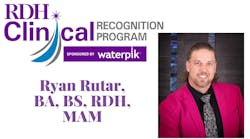RDH Clinical Recognition Program winner: Ryan Rutar, BS, BA, RDH, MAM
Each month, the RDH Clinical Recognition Program, sponsored by Water Pik, Inc., features a dental hygiene clinician who goes the extra mile in their job to change their patients’ lives, influence their patients’ health, and make a daily difference. Here we honor Ryan Rutar, BS, BA, RDH, MAM.
On the front lines of oral health
For Ryan Rutar, RDH, MAM, BS, BA, clinical hygiene provides fulfillment and a sense of purpose. As someone who is involved in the direct delivery of oral health and prevention, Ryan plays a crucial role in maintaining patients’ well-being and ensuring they receive the care they need. He constantly strives to introduce patients to new products or techniques that can work for them.
“The relationships we build and the assistance we provide can indeed feel like we are leaving a lasting legacy of well-being for the individuals we serve,” Ryan says.
Know a deserving dental hygienist? Nominate them today
Ryan appreciates being on the front lines of the oral health prevention world, collaborating and working with different companies and communities to try to solve the disparity of dental care. His dedication goes beyond the routine with the creation of a consulting business that is dedicated to helping hygienists and dentists build a cohesive and prevention-focused environment, empowering hygienists to manage themselves and lead their dental practices toward greater success.
Anxiety and creating a safe space
Another area of interest is speaking to dental hygienists on the topic of anxiety and how to manage it with their patients and in their own lives. Dental anxiety is common and can often feel overwhelming. Ryan ensures that patients receive not only the oral health care they need, but also the tools to manage their anxiety effectively.
Ryan created the Rutar Meditation Toothbrush Technique as a unique approach to integrate focused meditation to elicit brain health and proper brushing. This technique uses focused meditation to slow down the brain waves, effectively reducing stress. Incorporating mindfulness into the act of brushing not only promotes a sense of anticipation for the activity but also encourages individuals to concentrate on the task at hand, fostering a mindful approach to oral care.
Ryan is committed to creating an environment that is safe and inviting for the LGBTQ+ community. He speaks with fellow hygienists and dentists to create inclusivity and cultural humility in health care. “My hope is that this will contribute to a more compassionate and understanding dental society,” he says.
“The comments expressed by my patients are truly heartwarming and inspiring to me. Phrases like ‘if you go anywhere else, I’m following you’ or ‘You can’t leave or retire’ demonstrate the profound impact I’ve had on their lives,” he continues. “The relationships I’ve cultivated with these individuals have gone beyond the role of a health-care provider, forging a strong bond founded on trust, care, and a shared commitment to their overall well-being. It allows me to feel that I am making a difference, and it’s a good reminder that I chose the right profession.”
Professional guidance for new graduates
“In your job interview, always ask the dentist, ‘Under your leadership, how do you collaborate with the hygienists to contribute to the growth of the practice?’ This has a dual purpose: First, it will gauge the dentist’s openness to collaboration with the dental hygiene team. Second, it will demonstrate your strategic thinking about the business and your understanding of how hygienists play a vital role as providers in the office.
And make sure you attend national conventions! These events provide opportunities to rejuvenate your enthusiasm for hygiene, allow you to meet the movers and shakers in the dental hygiene profession, and give you a chance to explore what’s possible.”
Clinical tips
“When applying sealants on kids or adults, enhance the experience by having them hold the cotton roll farthest away from you with their index finger, while you hold the other. This gives the patient a sense of control, minimizes the likelihood of gagging, and frees up one of your much needed hands for a more efficient procedure.
“When communicating with patients about their treatment plan for the day, make sure you let them know that today’s session is focused on preventive care. By framing it as their prevention care appointment, you instill a sense of value that it is more than a cleaning. It may prompt them to ask questions, fostering a more engaged and informed patient experience.”
Ryan can be reached at:
facebook.com/ryan.rutar
Instagram: ryan_rutar
LinkedIn.com/in/ryanrutarrdh






